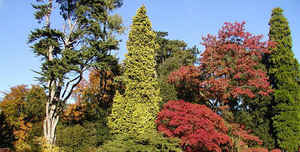
Tennessee Symbols
Tennessee State Bicentennial Tree
Yellowwood Tree

Cladrastis kentuckea (formerly Cladrastis lutea)
Adopted in 1991.
See also the Tennessee Tree Tulip/Yellow PoplarThe Yellowwood tree, (Cladrastis kentuckea,) was designated as the Official Bicentennial Tree of Tennessee by Senate Joint Resolution Number 62 of 1991. The resolution stated that the Yellowwood tree, scientifically known as Cladrastis lutea, is a native Tennessee ornamental tree of unsurpassed beauty, worthy of being grown in yards and public spaces across Tennessee and should serve as a tribute to the pioneering spirit of those individuals whose courage and perseverance paved the way for the settlement of the great state of Tennessee.
Tennessee State Bicentennial Tree:
Yellowwood Tree

The American
Yellowwood is a medium sized tree reaching 35' to 50' tall and about the same in spread (40' - 50' wide). The habit of yellowwood is vase shaped to
broad spreading when young, then gradually opening to a broad rounded form. Bright green leaves, which are alternate, odd-pinnately compound with 7-9
leaflets turn yellow in the fall. The bark of Cladrastis is a very smooth gray resembling that of a beech tree. The wood just beneath the bark is yellowish,
hence the name yellowwood. Flowers of the yellowwood are white, pendulous terminal panicles, 10" - 12" long, appearing in late May to early June. Flowering
tends to be heavy on alternate years.
Yellowwood is native to Kentucky, Tennessee, North Carolina and surrounding states. Hardiness ranges from Zone 4 to Zone 8. Yellowwood
tolerates a wide variety of soil conditions. With the ability to withstand limestone or acid soils as well as being drought tolerant, yellowwood should
become a very popular flowering landscape tree. Yellowwood is seed propagated and field grown. It is easily transplanted and establishes very nicely.
There are very few problems with yellowwood. With its beautiful flowers, fall color, adaptability, shape and size, yellowwood could be one of our most
popular native trees for landscape use.
Characteristics of the Yellowwood Tree

Cladrastis kentukea, the Kentucky yellowwood or American yellowwood (syn. C. lutea, C. tinctoria), is a species of Cladrastis native to the Southeastern United States, with a restricted range from western North Carolina west to eastern Oklahoma, and from southern Missouri and Indiana south to central Alabama. Also the tree is sometimes called Virgilia.
Family: Leguminosae or Fabaceae
Hardiness Zones: 4 to 8
Height: 40 ft Spread: 35 ft Form: (Vis. 1) rounded
Type: deciduous tree
Annual Growth Rate: less than 12 inches
Leaf: Pinnately compound leaflets are alternate along rachis, Rachis base completely surrounds bud
Buds: Brown and fuzzy and leaf scar completely encircles bud, as in Platanus
Bark: Smooth light gray very beechlike, quite attractive, and name yellowwood comes from the yellow heartwood
Flowers: White, pea-like flowers, fragrant, in 10" to 16" long clusters, bloom time is early June, resembles wisteria flowers, and blooms heavily every 2 or 3 years
Fruit: Flattened pod several seeds 2.5" to 4" long green pods that turn brown in October.
Culture: Full sun, likes moist, fertile, well-drained soils, not too particular about pH, prune in summer to avoid "bleeding" that occurs in winter and spring, and protect from winter sun and wind
Range: Found only in the Blue Ridge and Ridge and Valley regions of Georgia, usually on limestone cliffs and ridges and in Appalachian cove forests. Very rare in the wild. Prefers northfacing cove sites or river bank bluffs
Use: Ornamental, lawn tree, specimen for flowers and foliage, for attractive winter bark, for attractive fall foliage, and yellow dye and is used for carvings.
Tennessee Joint Resolution 62
The Yellowwood tree, Cladrastis kentuckea, was designated as the Official Bicentennial Tree of Tennessee by Senate Joint Resolution Number 62 of 1991.
Taxonomic Hierarchy: Yellowwood Tree
Kingdom: Plantae - Plants
Subkingdom: Tracheobionta - Vascular plants
Superdivision: Spermatophyta - Seed plants
Division: Magnoliophyta - Flowering plants
Class: Magnoliopsida - Dicotyledons
Subclass: Rosidae
Order: Fabales
Family: Fabaceae ⁄ Leguminosae - Pea family
Genus: Cladrastis Raf. - yellowwood
Species: Cladrastis kentukea (Dum. Cours.) Rudd - Kentucky yellowwood







